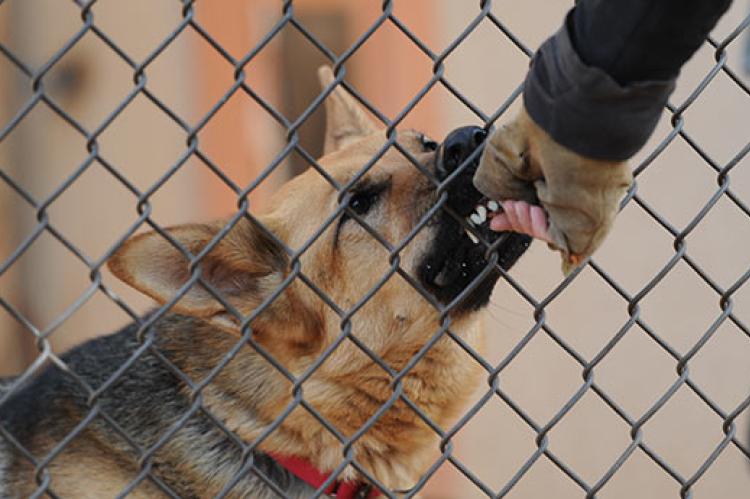How to Manage Dog Barrier Aggression and Frustration

It’s not unusual for a dog to react to people and/or other animals when behind a fence in their yard or a window in their home. They may bark, lunge, or growl when any of these stimuli are passing by. While it may look like the dog is showing signs of aggression, a better name for this is barrier reactivity, as there are often different root causes. Fortunately, there are ways to help reduce and prevent this reactivity.
What are the signs of dog barrier aggression (frustration)?
When a dog is barking, growling, jumping, lunging, or otherwise reacting to something from behind a barrier, that’s considered barrier frustration.
The gate, fence, door, or window acts as a barrier separating the dog from the trigger or stimulus to which they're reacting. That trigger or stimulus could be a variety of things — a human (either someone familiar or a stranger), another dog, a passing vehicle, a particular sound, or even something flapping in the breeze.
Again, while this may seem like aggression, much of the time it is rooted in fear, overexcitement, stress, anxiety, or frustration.
Preventing barrier reactivity in dogs
Your first step in working through this will be to assess ways in which you can prevent your dog from noticing the stimulus/trigger. Minimizing visual and audio access will help to decrease your dog’s stress level, making your training much easier.
First, observe when and where your dog becomes reactive to determine what the trigger is. Next, arrange your dog’s environment, so they won’t have the chance to react.
For example, if your dog is barking through a fence or window, try covering the view by putting up visual barriers along the fence line or by closing the curtains. If your dog becomes reactive when someone comes to the door, try putting them in another room before guests arrive. You can even turn on soothing music or give your dog a long-lasting treat (such as a frozen Kong stuffed with peanut butter) to help distract them from their trigger.
Remember, dogs are learning through every experience and interaction they have. Every time they get a chance to react to a trigger, they're rehearsing — and getting better at — barrier reactivity. So your goal when working on management is to set your dog up for success, which translates to them not reacting to the trigger.
Helping a dog overcome barrier frustration
If you’ve assessed your environment and made adjustments to help prevent reactivity but your dog is still reactive, the following steps can help diminish that response.
This technique can be used to reduce and eventually extinguish barrier reactivity. It is not intended for use with a dog who is reactive on a leash. Your first step is working on recall; if your dog has that solidified, then you can proceed to step 6.
- Gather high-value treats, and attach a long line to your dog either in your home, yard, or other large outdoor space.
- Start the game by moving backward from your dog while facing them. In a fun tone, say your dog’s name followed by the cue “come!”
- As your dog starts to run toward you, reel in the long line. Once they get up to you, mark that with a “yes” or a click from a clicker followed by a treat.
- If the dog doesn’t follow the first call, repeat again as you are reeling them in. Make this a fun game for them if they aren’t responding readily enough; lightly jog backward or around, so they are encouraged to catch you.
- Continue to practice this in different environments and with different distractions. You can phase out the long line as a reel and practice both on a regular walk as well as in your home. Once their recall is solid, you can proceed with modification for the reactivity.
- Gather high-value treats, attach a long line or regular leash to your dog, and start in the location where your dog displays reactivity.
- As they look out from the barrier, practice the cue “come.” Even if there isn’t a stimulus or trigger, they can start to generalize performing that command in the scenario where their stress level is highest.
- Continue to do this, and when the dog begins to react, cue “come” and offer several high-value treats and praise when they do. If they do not come to you immediately, you can use the leash to gently reel them in as you again offer the command “come.”
When you are not able to work on this, make sure your dog is not able to access the barrier they react behind. You want to make sure during the learning period that anytime they have access you are working with them.
As you work with a dog, here are some things to keep in mind:
- Always use a calm, gentle tone.
- Keep sessions short: five minutes or less at first.
- Remember to take breaks. Stop and take the dog out for a walk, or think of another activity your dog might enjoy, such as playing catch or sniffing around the yard.
- Be patient but optimistic. Progress might be slow, but it will happen. Keep a journal of your training sessions to track your progress.
Note: Please use caution at all times when working on behavior modification. It’s important to establish and maintain a positive relationship with the dog; once you have that, you will be able to make good progress with behavior modification techniques.